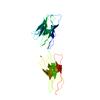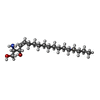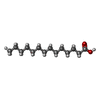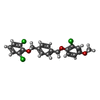+Search query
-Structure paper
| Title | Crystal structure of CD155 and electron microscopic studies of its complexes with polioviruses. |
|---|---|
| Journal, issue, pages | Proc Natl Acad Sci U S A, Vol. 105, Issue 47, Page 18284-18289, Year 2008 |
| Publish date | Nov 25, 2008 |
 Authors Authors | Ping Zhang / Steffen Mueller / Marc C Morais / Carol M Bator / Valorie D Bowman / Susan Hafenstein / Eckard Wimmer / Michael G Rossmann /  |
| PubMed Abstract | When poliovirus (PV) recognizes its receptor, CD155, the virus changes from a 160S to a 135S particle before releasing its genome into the cytoplasm. CD155 is a transmembrane protein with 3 Ig-like ...When poliovirus (PV) recognizes its receptor, CD155, the virus changes from a 160S to a 135S particle before releasing its genome into the cytoplasm. CD155 is a transmembrane protein with 3 Ig-like extracellular domains, D1-D3, where D1 is recognized by the virus. The crystal structure of D1D2 has been determined to 3.5-A resolution and fitted into approximately 8.5-A resolution cryoelectron microscopy reconstructions of the virus-receptor complexes for the 3 PV serotypes. These structures show that, compared with human rhinoviruses, the virus-receptor interactions for PVs have a greater dependence on hydrophobic interactions, as might be required for a virus that can inhabit environments of different pH. The pocket factor was shown to remain in the virus during the first recognition stage. The present structures, when combined with earlier mutational investigations, show that in the subsequent entry stage the receptor moves further into the canyon when at a physiological temperature, thereby expelling the pocket factor and separating the viral subunits to form 135S particles. These results provide a detailed analysis of how a nonenveloped virus can enter its host cell. |
 External links External links |  Proc Natl Acad Sci U S A / Proc Natl Acad Sci U S A /  PubMed:19011098 / PubMed:19011098 /  PubMed Central PubMed Central |
| Methods | EM (single particle) / X-ray diffraction |
| Resolution | 3.5005 - 9.0 Å |
| Structure data | EMDB-1562: CryoEM reconstructions of PV3 complexed with deglycosylated CD155 EMDB-1563: CryoEM reconstructions of PV2 complexed with deglycosylated CD155 EMDB-1570: CryoEM reconstructions of PV1 complexed with deglycosylated CD155  PDB-3uro: |
| Chemicals |  ChemComp-SPH:  ChemComp-MYR:  ChemComp-SC4:  ChemComp-HOH: |
| Source |
|
 Keywords Keywords | VIRUS / CD155 structure Immunoglobulin Superfamily / poliovirus capsid jelly role / Cell adhesion / Cell membrane / Glycoprotein / Host-virus interaction / Immunoglobulin domain / Membrane / Receptor / Secreted / Transmembrane / VIRAL PROTEIN / poliovirus receptor ectodomain / Immunoglobulin Super Family |
 Movie
Movie Controller
Controller Structure viewers
Structure viewers About Yorodumi Papers
About Yorodumi Papers









 homo sapiens (human)
homo sapiens (human)
 human poliovirus 1 mahoney
human poliovirus 1 mahoney